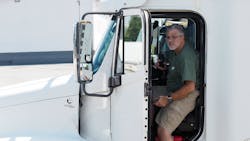Want to keep drivers connected? Be welcoming at your office and terminals.
Think of all the ways companies send a message to their employees that they are respected and valued. Calling them associates instead of employees. Proclaiming an open-door policy as a signal that employees are listened to. Repeating the mantra that employees are the company’s greatest asset.
Now think of the ways companies undercut their own message.
In for-hire trucking, one of the more common methods, however unintentional, is the driver window or counter. It’s the gatekeeper to the company. And, the “window” is also in play with many private fleets -- especially those using driver services. Those “contract drivers” – wearing the uniforms they’re contracted to, are in essence, treated as an outsider.
Separating drivers from the rest of the company is counterproductive. Drivers are the revenue engine of the business; or, for private fleets, the face of your product when a delivery is made. So, why would you wall them off from your business? Why treat them like they’re customers at a McDonald’s drive-thru?
In all the other industries I’ve worked in or served, I’ve never seen anything like trucking’s “driver window.” Can you imagine an airline telling its pilots they weren’t allowed into the offices?
Even after 11 years working on the Best Fleets to Drive For program, I still come across fleets that employ some variation of the window/counter. Even some of our Best Fleets finalists have made passing comments about drivers “at the window,” which begs the question: is there a legitimate business reason to have them?
The common response? “If too many drivers arrive at the office at the same time, they’ll disrupt other people’s work,” or “drivers can get belligerent so they need to be separated from office staff to minimize arguments and prevent violence.”
Hmm, those don't seem like great reasons. I’m not saying those situations haven’t happened in the past, but there are much better solutions than barring them from entering the facility.
If drivers are bitter and raising their voices at dispatch, that problem needs to be solved long before locking them out of the building. If there is continual disagreement between drivers and dispatch, then that’s a huge problem for the company and it needs to be addressed. Locking them out of the building because of potential conflict ensures their behavior is never going to improve. Drivers are certainly not going to feel that the company is listening to them; that the company is serious about fixing things. They’re going to feel more isolated, less valued, and more disposable.
Similarly, if drivers disrupt office staff because they’re chatty when they arrive at the office, maybe it’s because they’ve been out on the road, alone, for the past several days and need someone to talk to. Instead of locking them out, designate a driver services rep, driver manager, concierge, or whatever title fits, and have that person be available to chat with the drivers when they return. We’ve been seeing a move in that direction among Best Fleets participants for the past several years and it works really well.
I’m not saying that drivers should have wide open access to everything under the sun. If a fleet has a division handling highly sensitive or valuable freight, it makes perfect sense to have those areas extra secure and require special clearance to get in. But those rules apply to everyone in the company equally. It’s not a drivers vs. everyone else situation.
Driver windows are an obvious, physical way to create separation in the company, but there are other less obvious physical separators as well. Think about the driver room or driver lounge that most fleets have. Why is it a “driver lounge,” and not just a lounge? Why is it a “driver’s room” and not just a break room?
The reason, in many cases, is that these are separate places for drivers that the office people don’t use (usually because they have their own, nicer facilities). The implication is that drivers and office staff don’t or shouldn’t mingle. That’s counterproductive since you need everyone in the company to work together as a single unit in service of the company’s objectives.
I understand the broader objective of these spaces – having a place for drivers to relax and do their work while at the terminal – but that could be served equally well with shared-use facilities, allowing office staffers and drivers to get together in groups to collaborate. No need to keep people separated.
We talk to a lot of fleets that have a lot of great things happening, and it seems like sometimes the whole issue of the driver window is something that hasn’t occurred to them that they should change. Many people who have been in the industry for a long time (both drivers and office staff) just accept things as standard operating procedure. They develop a blind spot and don’t even consider the notion, “maybe it’s time for a change.”
With the driver shortage being what it is, and expected to get worse before it gets better, fleets need to do everything they can to make drivers feel like the star performers and revenue machines that they are. Otherwise, it’s going to be very difficult to attract good talent.
Mark Murrell is co-founder of CarriersEdge, a leading provider of online driver training for the trucking industry, and co-creator of Best Fleets to Drive For, an annual evaluation of the best workplaces in the North American trucking industry produced in partnership with Truckload Carriers Association.
About the Author

Mark Murrell
Mark Murrell is president of CarriersEdge, a provider of online driver training for the trucking industry, and co-creator of Best Fleets to Drive For, an annual evaluation of the best workplaces in the North American trucking industry.
